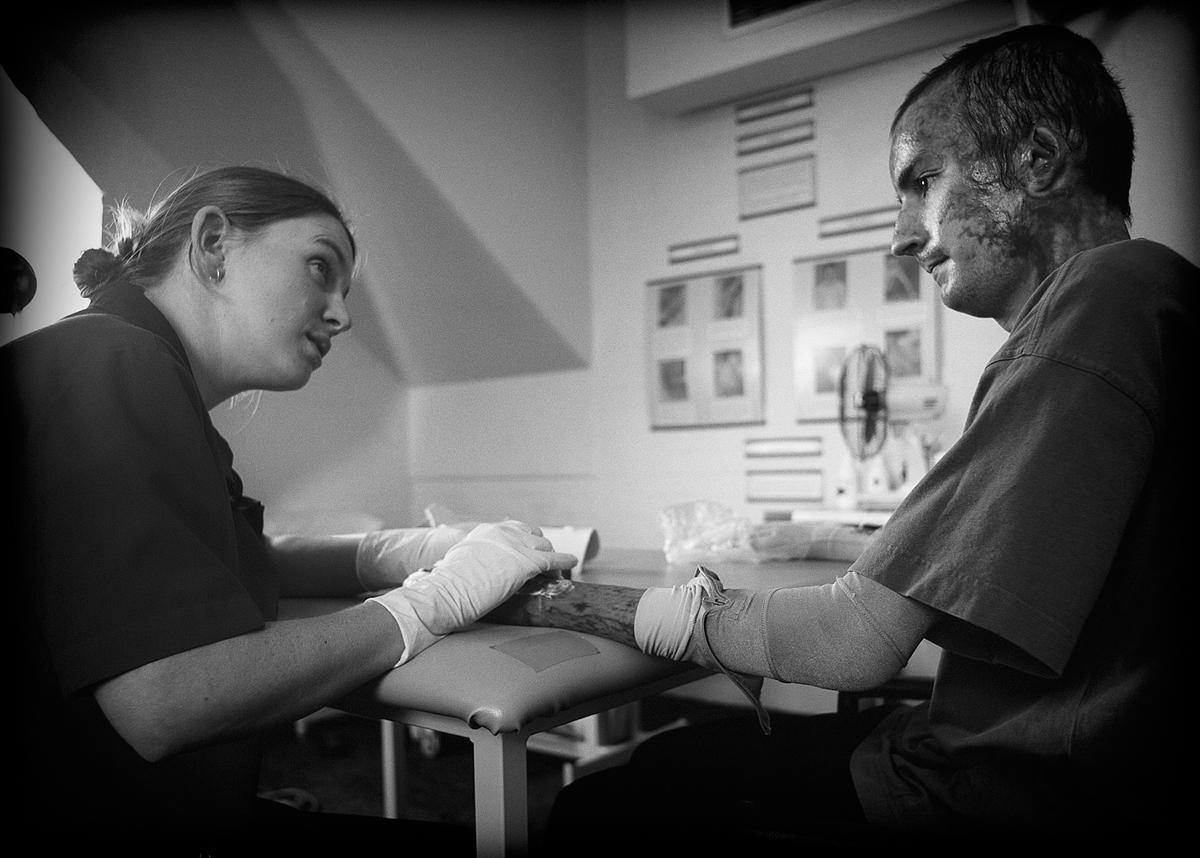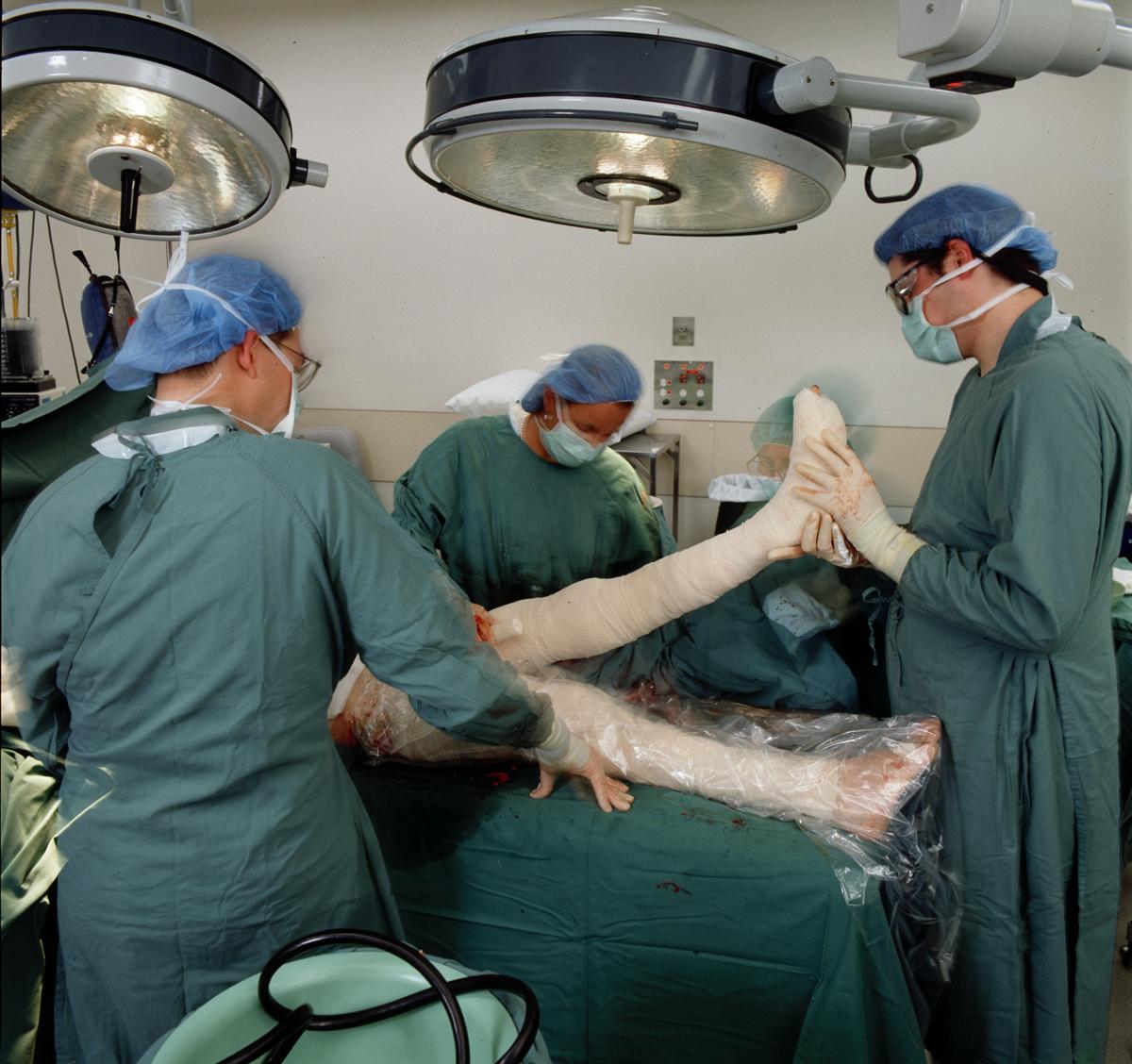RPH Museum
On 12 October 2002, three bombs exploded on the Indonesian island of Bali. The terrorist attack killed 202 people from 21 countries and injured many more.
Eighty-eight Australians lost their lives.
Many injured were flown to the Royal Perth Hospital for treatment. This exhibition reflects upon their experiences and those of the medical staff who cared for them.
Warning: This photographic exhibition contains images and accounts of a terrorist attack.
This exhibition was created by the Royal Perth Hospital with the support of survivors, past and current RPH staff, and the Western Australian Museum. In addition to this online exhibition, a physical exhibition is showing in the Old Gaol at WA Museum Boola Bardip until the 12th February 2023.
First Responders
Balinese hospitals were overwhelmed after the bombings.
RPH plastic surgeon Vijith Vijayasekaran and anaesthetist Priya Thalayasingam were holidaying on Bali and assisted with the crisis.
Amidst the chaos, the couple supported health workers at Bali’s Sanglah Hospital by resuscitating patients, performing lifesaving incisions to release pressure from swelling skin, and coordinating evacuations.
Vijith urgently relayed the critical nature of injuries to the RPH Burn Unit.
Below: First Responders Priya Thalayasingam (left) and Vijith Vijayasekaran (right) in Bali. Courtesy Vijith Vijayasekaran.

Evacuation
Following the attack, 66 injured people were evacuated to Australia.
Many were flown to the National Triage Centre at Darwin Hospital and then sent to hospitals around the country.
Twenty-eight people were sent to RPH, the closest Burn Unit.
To help RPH deal with the surge of critically injured patients, other major hospitals prepared to handle local emergencies.
Below: Kingsley Football Club player Phil Britten arriving at Royal Perth Hospital. Courtesy Tony McDonough.

Disaster Planning
Collaborative hands-on disaster training helped RPH respond to the Bali bombings.
Just 12 months before the attack, RPH, the Health Department and Woodside Petroleum had carried out a mock evacuation of the North Rankin oil platform off Karratha.
After testing the plan’s effectiveness on the oil rig, RPH and the Health Department were working on state and national burn disaster plans.
But of course, Bali happened… so we did it for real.
Fiona Wood, Former RPH Burn Unit Director
Below: Disaster management planning, Director of Clinical Services Bill Beresford and Acting CEO Phil Montgomery. Courtesy Royal Perth Hospital.

Race Against Time
In accordance with its disaster plans, RPH cleared Intensive Care and Burn Units for new arrivals, cancelled elective surgery, and placed operating theatres on standby.
Additional staff were provided to RPH by other major hospitals and equipment and supplies were gathered. The Physiotherapy Department began to make props and supports.
The nine-bed Burn Unit trebled in size overnight, expanding into nearby wards.
Below: Staff at RPH gather supplies. Dressings are a vital part of a patient’s care. Courtesy Royal Perth Hospital.

Arrival
Just over 24 hours after the explosions, the first evacuees arrived by private jet. Eleven were transferred to the RPH Burn Unit.
Within 48 hours another 12 critically injured burn patients arrived by Royal Australian Air Force Hercules. Others with shrapnel and glass injuries went to Fremantle and Sir Charles Gairdner Hospitals.
Commercial flights also evacuated patients to Perth and a private jet owned by businessman Kerry Stokes flew home 11 surviving Kingsley Football Club members.
Below: A patient being assessed on the tarmac on arrival in Perth. Courtesy Royal Perth Hospital.

Survival
I escaped the inferno of the Sari Club with the aid of a brave Balinese man who came to my aid. After being treated in Bali I was airlifted to an Australian hospital where I was told I would not survive. The extent of my injuries was severe with burns to 64% of my body, shrapnel wounds and the loss of hearing.
I spent 44 days in an induced coma battling severe infection and to this day I still suffer from the psychological trauma of that night.
But I consider myself one of the lucky ones.
Antony Svilicich
Below: Occupational therapist Megan Blakeway and Antony Svilicich. Courtesy Royal Perth Hospital.

Heated Operating Theatres
A major burns theatre requires many nurses, doctors and specialists and a controlled environment. Carmel McCormack, Nursing Director RPH Theatres, helped prepare for patients’ arrival.
I contacted Engineering to arrange for the theatres to have their temperatures adjusted to a maximum of 40°C. As burns patients have no skin coverage, a warm environment helps to protect them from hypothermia.
Carmel McCormack
Below: Patricia Dixon, theatre nurse and BU Director Fiona Wood in heated operating theatre. Courtesy Royal Perth Hospital.

Infection Control
Following the bomb blast many people with burns jumped into swimming pools. Contaminated water combined with ‘dirty bombs’ containing cow dung caused infections resistant to most antibiotics.
Being admitted with a burn injury is possibly one of the most challenging times of a person’s life. To protect them from infection, they are isolated from the world in the burn unit bubble. This isolation is compounded by intense pain with even the simplest of movements.
Dale Edgar
Former Head of Physiotherapy RPH Burn Unit
Below: During a burns debridement procedure, dressings and bandages need to be applied quickly to minimise exposure to infection. Courtesy Royal Perth Hospital.

Teamwork
Up to 12 surgeons and 28 nurses worked simultaneously, operating for many hours at a time.
In a hospital-wide response, cleaning, supplies management, specialised catering, ward restructuring, psychological and pastoral care had to be coordinated.
Support also came from the public, with people queuing outside the Red Cross to donate blood.
For the months that patients and staff bunkered down for the grind of recovering after skin grafting surgeries and painful rehab, there were daily platters of food provided from business owners and public.
Dale Edgar
Below: RPH Theatre staff anaesthetise a patient in preparation for burns treatment and new dressings.

Rehabilitation
Kingsley Football Club player Phil Britten was injured when a bomb exploded outside Kuta’s Sari Club. To aid his recovery, the 22-year-old participated in an intense physiotherapy program at the ‘Bali gym’, a daily group exercise session at RPH.
As soon as I arrived, they began work on getting me moving. It wasn’t just physical, it was getting me motivated mentally as well.
Phil Britten
Below: Head Physiotherapist Dale Edgar and Phil Britten in the Bali gym, which lived on by name until 2015. Courtesy Royal Perth Hospital.

Recovery and Loss
David Fyfe was metres away when a bomb detonated in Paddy’s Bar. He received burns to half his body and was operated on in Sanglah Hospital and on the tarmac in Bali. He awoke in RPH 13 days later. His leg was amputated to save his life and he received treatment with spray-on skin.
Below: David Fyfe and Physiotherapist Wendy Lee. Courtesy Royal Perth Hospital.

Despite the efforts of hospital staff, three people died in Royal Perth Hospital.
Below: Plaque on the King's Park Bali Memorial where sixteen Western Australians who died as a result of the bombings are remembered. Courtesy Royal Perth Hospital.
